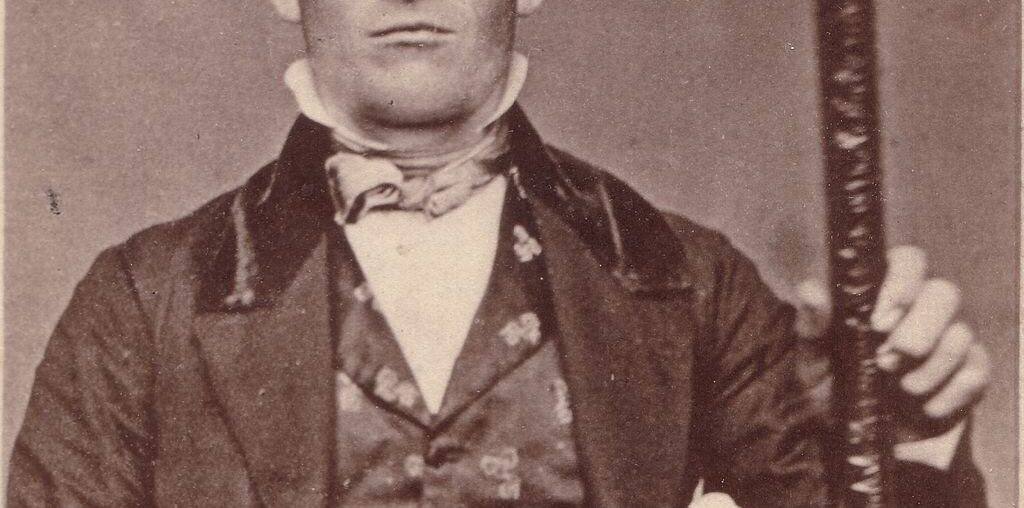Phineas Gage in the time after his accident.
Phineas Gage is perhaps the most famous neurological patient in modern history, called one of the “great medical curiosities of all time” and a “living part of medical folklore.” Malcolm MacMillan of the University of Melbourne records that two-thirds of introductory psychology textbooks cover Gage and his significance: “He was the first case where you could say fairly definitely that injury to the brain produced some kind of change in personality.” At the time, study of the brain is very rudimentary. Phrenologists, who accessed personalities by calculating protrusions on the skull, are still respected. The famous case of Phineas Gage will become a critical step in modern brain science.
September 1848
The young, robust, gregarious lad is employed as munitions foreman for the Rutland & Burlingame Railroad in Vermont. It is the most dangerous job in the crew. A standard blasting procedure involves boring a hole deep into rock, stuffing it with explosive powder and fuse, then using a tamping iron to pack in sand or clay to contain and direct the blast. Proud of his profession, Gage commissions an especially large custom-made tamping rod: three feet seven inches long, 1.4″ in diameter, and weighing over thirteen pounds.
The most dreaded mishap in munitions is a premature explosion.The tamping rod rockets into the left side of Gage’s face in an upward direction just past the lower jaw angle. Traversing the upper jaw and fracturing the cheekbone, it passes behind the left eye, through the left side of the brain, and flies out the top of his skull.
Gage is catapulted, lands hard on his back, convulses for a time, but is able to speak after a few minutes. He walks with little assistance and sits upright in an oxcart for a bumpy one mile ride to his town lodgings. True to the pioneer macho man legend, Gage shrugs off the injury, announcing he is not “much hurt” and expects to be back at work in a few days. His recovery from this horrific event is one of top medical stories of the era. Doctors worldwide exchange ideas and theories on the details and implications of the accident. For the next generation, it becomes the standard against which other injuries to the brain are judged. Some refuse to believe that anyone could survive such an ordeal – it must be a fabrication or a trick.
Despite his own optimism, Gage’s convalescence is long, difficult, and uneven, which requires further attendance by his physician, John M. Harlow, who garners fame as the doctor who treats the man who should not be. By April 1849, the patient is proclaimed to be in good physical health. Gage has, however, lost vision in his left eye and sustains a large forehead scar and a deep depression on top of his head “beneath which the pulsations of the brain can be perceived,” Dr. Harlow noted. “He has no pain in his head but says it has a queer feeling which he is not able to describe.”
After recovery
For a brief time after recovery, Gage exploits his newfound fame as a one-man traveling exhibit at New England venues, including an event organized by P.T. Barnum, where he is the object of both morbid curiosity and praise. This sort of exposure is soon overexposed, and the still robust Gage continues to work at various jobs as a farmer, stable and coach service owner, and a long-distance stagecoach driver, but he suffers from occasional seizures and then epilepsy, dying in 1860 twelve years after his injury. There are many reports that he underwent dramatic and negative personality changes – becoming a dishonest, ill-tempered, brawling lout. Gage’s steady work history and other contemporary assessments suggest such claims are exaggerated.
Phrenologists contended that destruction of the mental “organs” of Veneration and Benevolence caused Gage’s behavioral changes. Harlow may have believed that the organ of Comparison was damaged as well.
Dr. Harlow requests and receives the patient’s skull. He is bequeathed the most famous tamping rod in history, which Gage carried wherever he went, inscribed: This is the bar that was shot through the head of Mr Phineas P. Gage at Cavendish, Vermont, Sept 14, 1848. He fully recovered from the injury & deposited this bar in the Museum of the Medical College of Harvard University.
These artifacts, along with a plaster cast of Phineas Gage’s head created during an 1850 examination, are the most sought-out items at the Warren Anatomical Museum on the Harvard Medical School campus.
Terry Hamburg is director emeritus of the Cypress Lawn Cemetery Heritage Foundation. His recently published book Land of the Dead: How The West Changed Death In America explores how the demands of survival and adaptation in the Gold Rush western migration changed a multitude of American customs, including the way we bury and grieve for our ancestors. California and San Francisco serve as case studies. Visit his author page: https://www.terryhamburgbooks.com.

